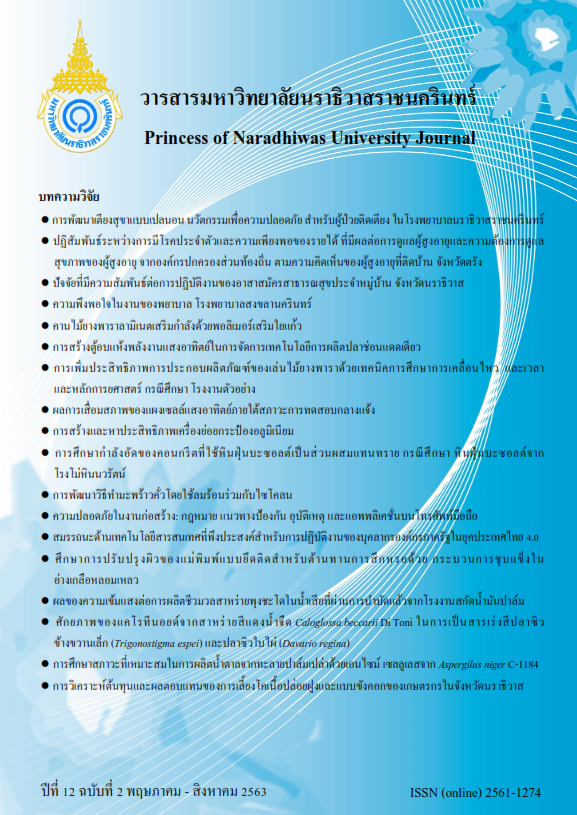Efficiency Improvement in Assembly Rubber Wooden Toys Using Motion and Time Study and Principles of Ergonomics: A Case Study of a Sample Factory
1 Faculty of Engineering, Rajamangala University of Technology Srivijaya, 2 Faculty of Engineering, Princess of Naradhiwas University
Keywords:
Motion and time study, Ergonomics, Rubber wooden toys, Efficiency, Standard timeAbstract
The objective of this research was to study a assembling process of rubber wooden camera toy using time and motion study and ergonomics principles. From the investigation of the toy assembling process, it was low assembling efficiency because the assembling procedure and working motions were inappropriate which affected the exuasted workers and waste time in the process. Thus, the researcher applied the time-motion study, ECRS technique and ergonomics method to improve the operating procedure and also design the ergonomical tables and chairs. After the process improved, the number of assembly processes was reduced from 8 steps to 7 steps and the standard assembling times was also reduced from 3.254 minutes/piece to 2.508 minutes/piece (0.746 minute/piece reduction). Moreover, the efficiency of assembling process increased 25.96 percent. In case of the working motions, after the ergonomics assessment with RULA method and fatigue survey, the risks in assembling process can be reduced to the satisfactory level.
References
Adnan, A. N., Arbaai, N. A., & ismail, A. (2016). Improvement of Overall Efficiency of Production Line by Using Line Balancing. Journal of Engineering and Applied Sciences, 11(12), 7752-7758.
Barnes, R.M. (1980). Motion and Time Study Design and Measurement of Work. (7th ed.) New York: John Wiley & Sons. USA.
Biswas, S. Chakraborty, A. & Bhowmik, N. (2016). Improving Productivity Using Work Study Technique. International Journal of Research in Engineering and Applied Sciences, 6, 49-55.
Bon, A.T. & Samsudin, S.N.A. (2018). Productivity Improvement in Assembly Line by Reduction Cycle Time using Time Study at Automotive Manufacturer. Proceedings of the International Conference on Industrial Engineering and Operations Management Bandung, Indonesia, March 6-8, 284-291.
Chandra, P.V. (2013). An Effort to Apply Work and Time Study Techniques in a Manufacturing Unit for Enhancing Productivity. International Journal of Innovative Research in Science, Engineering and Technology, 2(8), 4050-4058.
Chitsamran, A. & Kengpol, A. (2014). Productivity Improvements by Using Standard Time and Design for Assembly: A Case Study in a Transformer Manufacturing Plant. IE Network Conference, 30-31 October. Samutprakarn. 467-471. (In Thai).
Department of Industrial Promotion. (2003). Children's Toys Made from Rubberwood. Retrieved from http://www.library.dip.go.th. (in Thai).
Freivalds, A. & Niebel, B. (2013). Niebel's Methods, Standards, & Work Design. New York: McGraw-Hill. USA.
Hassanali, K.N. (2011). A Productivity Model Utilizing a Work Study Approach for Performance Measurement. The Journal of the Association of Professional Engineers of Trinidad and Tobago, 40, 13-25.
Kanjana, C. Supprat, N. Paramart, N. & Sooksaksun, N. (1971). The Application of ECRS Principle for Improving Process Case Study: Soil Production Industry. IE Network Conference, 30-31 October. Samutprakarn. 927-934. (In Thai).
Kanjanapanyakom, R. (2009). Industrial Work Study. Bangkok: Top Publishing. (in Thai).
Kulkarni, P.P.Kshire, S.S. & Chandratre, K.V. (2014). Productivity Improvement Through Lean Deployment and Work Study Methods. International Journal of Research in Engineering and Technology, 3, 429-434.
McAtoammy, L. & Corlett, E.N. (1993). RULA: A Survey Method for the Investigation of Work-Related Upper Limb Disorders. Applied Ergonomics, 24, 91-99.
Meyers, F.E. & Stewart, J.R. (2002). Motion and Time Study for Lean Manufacturing. (3rd ed.), New Jersey, Prentice Hall, USA.
Mishan, N.N. & Tap, M.M. (2015). Increasing Line Efficiency by Using Time study and Line Balancing in a Food Manufacturing Company. Jurnal Mekanikal Di, 38, 32-43.
Ozor, P.A. Chibuike, L.O.O. Orji, O. & Chimaobi, K.O. (2015). Productivity Improvement of Small and Medium Scale Enterprises using Lean Concept: A Case Study of a Bread actory. European Journal of Business and Management, 7, 73-84.
Phichitphajongkij, P. (2018) Improvement of Chassis Production Process of Truck Factory. Engng.J.CMU, 15(2). 55-66.
Rawangwong, S. (2011). Work study. (2nd ed.) Songkhla: Tam Publishing. (in Thai).
Rijiravanich, W. (2000). Work Study: Principle and Case Study. (2nd ed.) Bangkok: (in Thai).
Sanders, M.S., & McCormick, E.J., 1993. Human Factor in Engineering and Design. (7th ed.), McGraw-Hill, California, USA.
Sungkapong, A. & Pochana, K. (2013). Ergonomics and Assessment. Prince of Songkla University. Songkhla. (in Thai).
Teerawatsakul, I. (1999). Motion and Time Study. Department of Industrial Engineering, Faculty of Engineering, Chiang Mai University, Chiang Mai. (in Thai).
Tuntasut, V. Rijiwanit, W. Mahittafowkun, J. & Changsagawet, C. (2000). Work Study. (7th ed.). Chulalongkorn University Publisher. (In Thai).




